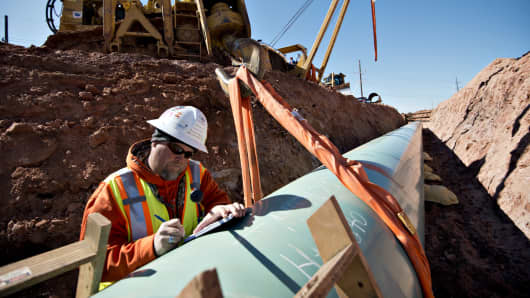"What we've got here is a small example of the type of risks associated with a tar sands pipeline," said Anthony Swift, a lawyer with the Natural Resources Defense Council, one of many environmental groups fighting the pipeline proposal, which is awaiting State Department approval. "It also demonstrates the large gaps in pipeline safety."
On Tuesday, vacuum trucks and crews were still working to clean up the accident, which the Environmental Protection Agency called a "major spill." While it was unclear how much oil had leaked, Exxon Mobil said it had recovered thousands of gallons of oil mixed with water and had prepared for a spill as large as 420,000 gallons, though it said it believed that the amount released was smaller.
"Our focus is on the safety of the people in the community and restoring the environment as soon as we possibly can," said Alan Jeffers, an Exxon Mobil spokesman. "We're committed to the cleanup and will stay until it's done."
(Read More: Obama Fast-Tracks Keystone Pipeline Segment)
The spill appears to be the largest accident involving heavy crude since an Enbridge Energy pipeline spill in 2010 that dumped more than 840,000 gallons near Marshall, Mich., soiling a 39-mile stretch of the Kalamazoo River.
Late Tuesday, the federal Pipeline and Hazardous Materials Safety Administration ordered Exxon not to restart the pipeline without getting approval, because of its proximity to populated areas and waterways, and because the initial investigation had not yet uncovered the cause of the spill.
The Arkansas spill followed an accident in Utah on March 18 in which a Chevron pipeline leaked more than 25,000 gallons of diesel fuel in a wetlands area about 50 miles from Salt Lake City.
"Chevron Pipe Line Company regrets this incident, and we are committed to remediating the affected area and mitigating all impacts on the environment," Gareth Johnstone, a Chevron spokesman, said in a statement.
The Chevron spill was the third in three years in Utah, prompting Gov. Gary R. Herbert to sharply criticize the pipeline agency at a recent news conference. "Obviously, they have not done a very good job of overseeing the pipes that travel between our states," he said.
(Read More: How BP Is Joining Big Oil Retreat From Renewals)
The safety records of both the Exxon and Chevron pipelines have been under scrutiny in recent years. Last week, the pipeline agency proposed imposing a $1.7 million fine on Exxon Mobil over a 2011 spill that dumped an estimated 63,000 gallons of oil in the Yellowstone River in Montana.
Records show that the pipeline agency has proposed a fine of about $150,000 in the same year over the company's failure to properly test several pipelines.
In June 2010, a Chevron pipeline spilled more than 33,000 gallons of crude into Red Butte Creek near Salt Lake City. The company took more than 10 hours to respond to the spill, and it was fined $423,600, according to pipeline agency records. Seven months later, a second Chevron spill sent an additional 21,000 gallons of oil into the same area.
Carl Weimer, a member of the agency's technical advisory committee, said he was told by a federal official that Chevron was thought to have misidentified the section of the pipeline that caused the spill last month.
According to Mr. Weimer, who runs a pipeline safety watchdog group, regulators believed that Chevron might have mistakenly classified the part of the pipeline in question as seamless in its integrity management plan, an internal document that helps guide inspections. In fact, the section had a seam, and it was of a type known to be subject to accidents, Mr. Weimer said.
Jeannie Layson, a spokeswoman for the pipeline agency, said it was investigating whether Chevron had correctly identified the types and ages of pipe in its integrity management plan.
However, Mr. Johnstone, the Chevron spokesman, said the company had indeed identified the part of the pipeline that ruptured as having a seam.
In recent years, critics have said that the pipeline agency has allowed pipeline companies too much autonomy in regulating their own operations. In 2011, Congress approved legislation that increased maximum fines that pipeline operators face for safety violations, among other measures.
Ms. Layson said the pipeline agency had become more aggressive in holding operators accountable for pipeline safety, while increasing enforcement and fines.
Last month, the State Department released a revised environmental impact statement on the Keystone XL pipeline, finding no conclusive evidence to keep the project from moving forward. A public hearing on the environmental report will take place this month in Nebraska. President Obama is expected to make a decision on the pipeline this year.


